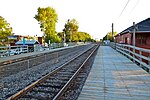LeBer-LeMoyne House
1671 establishments in the French colonial empireFrench colonial architecture in CanadaFur trade National Historic Sites of CanadaHeritage sites in Quebec (Cultural Heritage Act)Historic house museums in Quebec ... and 7 more
History of MontrealHouses completed in 1671Houses in MontrealLachine, QuebecNational Historic Sites in QuebecNew FranceUse Canadian English from January 2023

Le Ber-Le Moyne House (French: Maison Le Ber-Le Moyne) is the oldest complete building in Montreal, Quebec, Canada. It is located in the borough of Lachine, bordering the Saint Lawrence River, between the Lachine Rapids and Lake Saint-Louis. It is a recognized National Historic Site of Canada since June 19, 2002. The Le Ber-Le Moyne site and its archaeological collection have also been classified as heritage assets by the ministère de la Culture et des communications du Québec since 2001.
Excerpt from the Wikipedia article LeBer-LeMoyne House (License: CC BY-SA 3.0, Authors, Images).LeBer-LeMoyne House
Chemin du Musée, Montreal Lachine
Geographical coordinates (GPS) Address Nearby Places Show on map
Geographical coordinates (GPS)
| Latitude | Longitude |
|---|---|
| N 45.43 ° | E -73.666388888889 ° |
Address
Musée de Lachine
Chemin du Musée 1
H8S 2C5 Montreal, Lachine
Quebec, Canada
Open on Google Maps










